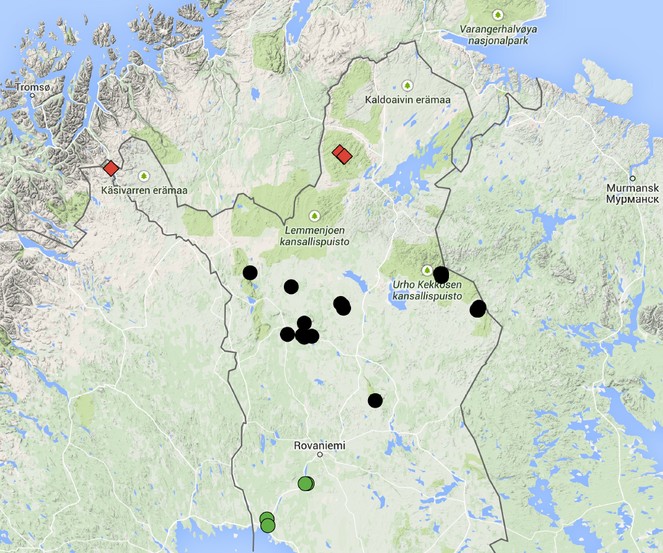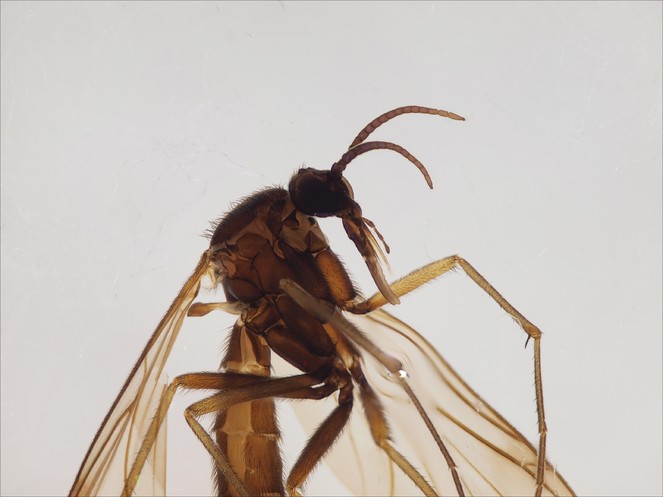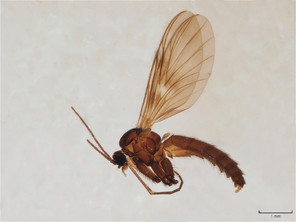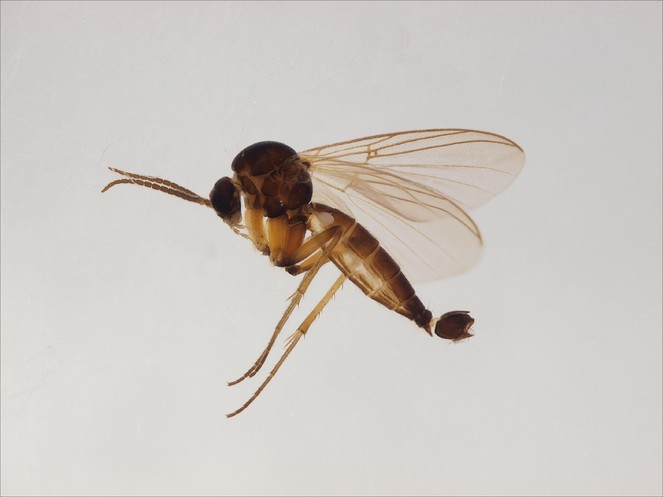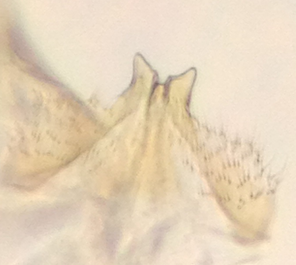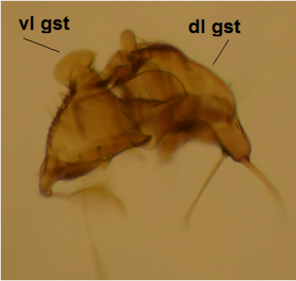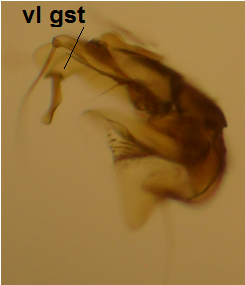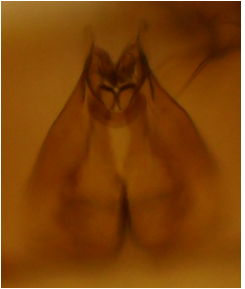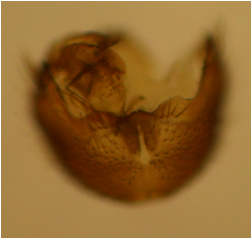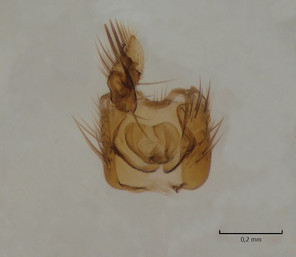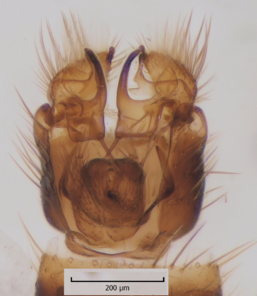|
Biodiversity Data Journal : Taxonomic paper
|
|
Corresponding author: Jukka Salmela (jukka.e.salmela@gmail.com)
Academic editor: Vladimir Blagoderov
Received: 01 May 2015 | Accepted: 20 Jun 2015 | Published: 25 Jun 2015
© 2015 Jukka Salmela, Kari M Kaunisto.
This is an open access article distributed under the terms of the Creative Commons Attribution License (CC BY 4.0), which permits unrestricted use, distribution, and reproduction in any medium, provided the original author and source are credited.
Citation: Salmela J, Kaunisto K (2015) Additions to the list of Finnish Bibionomorpha (Diptera, Nematocera). Biodiversity Data Journal 3: e5228. doi: 10.3897/BDJ.3.e5228
|

|
Abstract
A total of 12 gnat species are reported for the first time from Finland (3 Cecidomyiidae, 1 Keroplatidae, 8 Mycetophilidae), and the occurrence of Macrocera nigropicea Lundström in Finland is verified. All material was collected from the Finnish Lapland, mainly from the north boreal ecoregion. Two of the recorded species are likely to be pyrophilous, associated with forest fire sites. A photo of the ventral appendage of the gonocoxite of Brevicornu setigerum Zaitzev is provided for the first time. The male hypopygium of Mycetophila haruspica Plassmann is redescribed.
Keywords
Cecidomyiidae, Lestremiinae, Porricondylinae, Keroplatidae, Mycetophilidae, gall migdes, fungus gnats
Introduction
With over 52000 species globally, nematocerans or lower Diptera are one of the most species-rich insect groups in the world (
A list of Finnish Diptera was recently published (
Materials and methods
All material reported here was collected from Finnish Lapland (
A map of Finnish Lapland and the collecting locaties of the Bibionomorpha species reported in the present paper. Green dots=middle boreal ecoregion, black dots=north boreal ecoregion, red diamonds=subalpine ecoregion. The map was created by using Google Maps.
All material is deposited in the private collection of Jukka Salmela, Rovaniemi (JES). All specimens are stored in 70 % ethanol, kept in 2 ml plastic vials with screw cap and a rubber o-ring seal. Hypopygia of some specimens are kept in separate 0,5 ml microvials in glycerol.
Layer photos were taken using an Olympus E520 digital camera, attached to an Olympus SZX16 stereomicroscope. Digital photos were captured using the programmes Deep Focus 3.1 and Quick PHOTO CAMERA 2.3. Extended depth of focus images were reconstructed in the program Combine ZP.
Taxon treatments
Eomastix incerta
-
country: Finland; stateProvince:Lapponia kemensis pars orientalis; verbatimLocality:Savukoski, Urho Kekkonen National Park, Jaurujoki; verbatimLatitude:68.1196; verbatimLongitude:28.5888; verbatimCoordinateSystem:decimal degrees; verbatimSRS:WGS84; samplingProtocol:trunk window trap; eventDate:2014-7-1/8-5; habitat:burned, pine dominated forest, trap was set on a standing spruce; individualCount:1; sex:male; catalogNumber:DIPT-JS-2014-0247; recordedBy:J. Salmela; identifiedBy:J. Salmela; institutionCode:JES
-
country: Finland; stateProvince:Lapponia kemensis pars orientalis; verbatimLocality:Savukoski, Urho Kekkonen National Park, Jaurujoki; verbatimLatitude:68.1205; verbatimLongitude:28.5815; verbatimCoordinateSystem:decimal degrees; verbatimSRS:WGS84; samplingProtocol:trunk window trap; eventDate:2009-6-4/9-16; habitat:burned, pine dominated forest, trap was set on a standing spruce; individualCount:10; sex:8 male, 2 female; catalogNumber:DIPT-JS-2014-0276; recordedBy:J. Salmela; otherCatalogNumbers:DIPT-JS-2014-0243, DIPT-JS-2014-0341, DIPT-JS-2014-0492, DIPT-JS-2014-0493; identifiedBy:J. Salmela; institutionCode:JES
Distribution
European. The species (
Ecology
Larvae of Lestreminae are perhaps mostly saproxylic (
Forest fire site in Savukoski, Finnish Lapland, Urho Kekkonen National Park. Forest fire took place in 2013 and insect sampling (trunk-window traps) was performed in 2014. Two rare and poorly known ceciidomyiids, Eomastix incerta (Jaschhof) and Lestremia solidaginis (Felt), were caught. Both species are probably pyrophilous. Photo Jukka Salmela 6/2014.
Lestremia solidaginis
-
country: Finland; stateProvince:Lapponia kemensis pars orientalis; verbatimLocality:Savukoski, Urho Kekkonen National Park, Jaurujoki; verbatimLatitude:68.1174; verbatimLongitude:28.5814; verbatimCoordinateSystem:decimal degrees; verbatimSRS:WGS84; samplingProtocol:trunk window trap; eventDate:2014-8-5/9-16; habitat:burned, pine dominated forest, trap was set on a standing pine; individualCount:1; sex:male; catalogNumber:DIPT-JS-2014-0343; recordedBy:J. Salmela; identifiedBy:J. Salmela; institutionCode:JES
-
country: Finland; stateProvince:Lapponia kemensis pars orientalis; verbatimLocality:Savukoski, Urho Kekkonen National Park, Jaurujoki; verbatimLatitude:68.1191; verbatimLongitude:28.5844; verbatimCoordinateSystem:decimal degrees; verbatimSRS:WGS84; samplingProtocol:trunk window trap; eventDate:2014-8-5/9-16; habitat:burned, pine dominated forest, trap was set on a standing spruce; individualCount:1; sex:male; catalogNumber:DIPT-JS-2014-0350; recordedBy:J. Salmela; identifiedBy:J. Salmela; institutionCode:JES
-
country: Finland; stateProvince:Lapponia kemensis pars orientalis; verbatimLocality:Savukoski, Urho Kekkonen National Park, Jaurujoki; verbatimLatitude:68.1192; verbatimLongitude:28.5780; verbatimCoordinateSystem:decimal degrees; verbatimSRS:WGS84; samplingProtocol:trunk window trap; eventDate:2014-8-5/9-16; habitat:burned, pine dominated forest, trap was set on a standing pine; individualCount:4; sex:male; catalogNumber:DIPT-JS-2014-0352; recordedBy:J. Salmela; identifiedBy:J. Salmela; institutionCode:JES
Distribution
Holarctic. The species is known to occur widely in the Nearctic region, but in the Palaearctic recorded only from southern Sweden (
Ecology
Perhaps a pyrophilous species (
Porricondyla macrodon
-
country: Finland; stateProvince:Ostrobothnia borealis pars borealis; verbatimLocality:Keminmaa, Kallinkangas; verbatimLatitude:65.8173; verbatimLongitude:24.4995; verbatimCoordinateSystem:decimal degrees; verbatimSRS:WGS84; samplingProtocol:Malaise trap; eventDate:2014-7-28/9-23; habitat:rich fen; individualCount:1; sex:male; catalogNumber:DIPT-JS-2014-0470; recordedBy:J. Salmela; identifiedBy:J. Salmela; institutionCode:JES
Distribution
European. The species was described recently from southern Sweden, Uppsala and Tyresta (
Ecology
The holotype specimen was collected from an "open woodland with old oaks" (
Asindulum nigrum
-
country: Finland; stateProvince:Ostrobothnia borealis pars borealis; verbatimLocality:Tornio, Isonkummunjänkä Mire Conservation Area, Kusiaiskorpi; verbatimLatitude:65.888; verbatimLongitude:24.479; verbatimCoordinateSystem:decimal degrees; verbatimSRS:WGS84; samplingProtocol:Malaise trap; eventDate:2013-8-1/9-26; habitat:calcareous rich fen, rusty deposist; individualCount:1; sex:male; catalogNumber:DIPT-JS-2014-0115; recordedBy:J. Salmela; identifiedBy:J. Salmela; institutionCode:JES
Distribution
European. The species (
Ecology
Immature stages are unknown, but Orfeliini larvae are predaceous (
Conservation
The species is red-listed in Great Britain (NT,
Macrocera nigropicea
-
country: Finland; stateProvince:Lapponia kemensis pars occidentalis; verbatimLocality:Kittilä, Taljavaaranvuoma; verbatimLatitude:67.577; verbatimLongitude:25.362; verbatimCoordinateSystem:decimal degrees; verbatimSRS:WGS84; samplingProtocol:Malaise trap; eventDate:2007-6-25/7-24; habitat:rich fen; individualCount:6; sex:4 male, 2 female; catalogNumber:MYCE-NV-2013-0035; recordedBy:J. Salmela; identifiedBy:J. Salmela; institutionCode:JES
-
country: Finland; stateProvince:Lapponia kemensis pars occidentalis; verbatimLocality:Kittilä, Repsuvuoma; verbatimLatitude:67.605; verbatimLongitude:24.964; verbatimCoordinateSystem:decimal degrees; verbatimSRS:WGS84; samplingProtocol:Malaise trap; eventDate:2007-6-26/7-25; habitat:rich fen; individualCount:2; sex:male; catalogNumber:MYCE-NV-2013-0054; recordedBy:J. Salmela; identifiedBy:J. Salmela; institutionCode:JES
-
country: Finland; stateProvince:Lapponia kemensis pars occidentalis; verbatimLocality:Kittilä, Silmäsvuoma; verbatimLatitude:67.583; verbatimLongitude:25.543; verbatimCoordinateSystem:decimal degrees; verbatimSRS:WGS84; samplingProtocol:Malaise trap; eventDate:2007-6-25/7-25; habitat:rich fen; individualCount:2; sex:male; catalogNumber:MYCE-NV-2013-0057; recordedBy:J. Salmela; identifiedBy:J. Salmela; institutionCode:JES
-
country: Finland; stateProvince:Lapponia kemensis pars occidentalis; verbatimLocality:Kittilä, Nunaravuoma; verbatimLatitude:67.699; verbatimLongitude:25.353; verbatimCoordinateSystem:decimal degrees; verbatimSRS:WGS84; samplingProtocol:Malaise trap; eventDate:2007-6-1/6-27; habitat:poor sedge fen; individualCount:1; sex:male; catalogNumber:MYCE-NV-2013-0074; recordedBy:J. Salmela; identifiedBy:J. Salmela; institutionCode:JES
-
country: Finland; stateProvince:Lapponia kemensis pars occidentalis; verbatimLocality:Kittilä, Kielisenpalo; verbatimLatitude:68.021; verbatimLongitude:25.053; verbatimCoordinateSystem:decimal degrees; verbatimSRS:WGS84; samplingProtocol:Malaise trap; eventDate:2007-6-26/7-27; habitat:rich spring fen; individualCount:1; sex:male; catalogNumber:MYCE-NV-2013-0099; recordedBy:J. Salmela; identifiedBy:J. Salmela; institutionCode:JES
-
country: Finland; stateProvince:Lapponia kemensis pars occidentalis; verbatimLocality:Kittilä, Akharamanvuoma; verbatimLatitude:67.593; verbatimLongitude:25.308; verbatimCoordinateSystem:decimal degrees; verbatimSRS:WGS84; samplingProtocol:Malaise trap; eventDate:2007-6-25/8-2; habitat:rich pine fen; individualCount:5; sex:3 female, 2 male; catalogNumber:DIPT-JS-2014-0332; recordedBy:J. Salmela; identifiedBy:J. Salmela; institutionCode:JES
-
country: Finland; stateProvince:Lapponia kemensis pars orientalis; verbatimLocality:Savukoski, Törmäoja, Ahot; verbatimLatitude:67.817; verbatimLongitude:29.432; verbatimCoordinateSystem:decimal degrees; verbatimSRS:WGS84; samplingProtocol:Malaise trap; eventDate:2014-7-8/8-7; habitat:dry meadow; individualCount:2; sex:male; catalogNumber:DIPT-JS-2014-0414; recordedBy:J. Salmela; identifiedBy:J. Salmela; institutionCode:JES
-
country: Finland; stateProvince:Lapponia kemensis pars orientalis; verbatimLocality:Savukoski, Törmäoja, Ahot; verbatimLatitude:67.821; verbatimLongitude:29.436; verbatimCoordinateSystem:decimal degrees; verbatimSRS:WGS84; samplingProtocol:Malaise trap; eventDate:2014-7-8/8-7; habitat:margin of pond, surrounded by dry meadow; individualCount:1; sex:male; catalogNumber:DIPT-JS-2014-0474; recordedBy:J. Salmela; identifiedBy:J. Salmela; institutionCode:JES
Distribution
European. The species (
Ecology
Immature stages are unknown, but Macrocera larvae are predaceous and mostly associated with soil and dead wood (see e.g.
Sciophila arizonensis
-
country: Finland; stateProvince:Ostrobothia borealis pars borealis; verbatimLocality:Kemijärvi, Pyhä-Luosto National Park, Huttuoja; verbatimLatitude:66.9983; verbatimLongitude:27.0265; verbatimCoordinateSystem:decimal degrees; verbatimSRS:WGS84; samplingProtocol:Malaise trap; eventDate:2014-8-8/9-19; habitat:rusty spring brook, pine mire, close to riparian forest; individualCount:1; sex:male; catalogNumber:DIPT-JS-2014-0385; recordedBy:J. Salmela; identifiedBy:J. Salmela; institutionCode:JES
Distribution
Holarctic. The description of the species (
Ecology
Immature stages are unknown, but Sciophila larvae are fungivorous, living on the surfaces of agaric and polyporous fungi (
Malaise trap in Kemijärvi, Finnish Lapland, Pyhä-Luosto National Park, close to Huttuoja. The sampling site is a mixture of habitats, such as rusty spring brook, riparian forest and pine mire. Rare Holarctic fungus-gnat Sciophila arizonensis Zaitzev was identified from the trap material. J. Salmela 6/2014.
Sciophila fridolini
-
country: Finland; stateProvince:Lapponia inariensis; verbatimLocality:Inari, Muotkatunturi Wilderness Area, Ceavrajohoaivi; verbatimLatitude:69.1750; verbatimLongitude:26.2012; verbatimCoordinateSystem:decimal degrees; verbatimSRS:WGS84; samplingProtocol:Malaise trap; eventDate:2014-6-26/8-5; habitat:alpine headwater stream; individualCount:1; sex:male; catalogNumber:DIPT-JS-2015-0200; recordedBy:E. Rundgren; identifiedBy:J. Salmela; institutionCode:JES
Distribution
Holarctic. The species was described from Russia, Kola Peninsula (
Ecology
Immature stages are unknown, but S. fridolini is presumably a woodland species (
Sciophila spinifera
-
country: Finland; stateProvince:Lapponia kemensis pars orientalis; verbatimLocality:Sodankylä, Pomokaira, Paistipuolet NE; verbatimLatitude:67.834; verbatimLongitude:26.270; verbatimCoordinateSystem:decimal degrees; verbatimSRS:WGS84; samplingProtocol:Malaise trap; eventDate:2009-6-1/6-29; habitat:intermediate rich spring fen; individualCount:1; sex:male; catalogNumber:MYCE-NV-2013-0196; recordedBy:J. Salmela; identifiedBy:J. Salmela; institutionCode:JES
-
country: Finland; stateProvince:Lapponia kemensis pars orientalis; verbatimLocality:Sodankylä, Pomokaira, Poksaselkä E; verbatimLatitude:67.858; verbatimLongitude:26.259; verbatimCoordinateSystem:decimal degrees; verbatimSRS:WGS84; samplingProtocol:Malaise trap; eventDate:2009-6-1/6-29; habitat:spring brook surrounded by old-growth spruce forest; individualCount:1; sex:male; catalogNumber:DIPT-JS-2014-0317; recordedBy:J. Salmela; identifiedBy:J. Salmela; institutionCode:JES
-
country: Finland; stateProvince:Lapponia inariensis; verbatimLocality:Inari, Muotkatunturi Wilderness Area, Kielajoki; verbatimLatitude:69.1464; verbatimLongitude:26.2929; verbatimCoordinateSystem:decimal degrees; verbatimSRS:WGS84; samplingProtocol:Malaise trap; eventDate:2014-6-26/8-5; habitat:herb-rich swampy birch forest; individualCount:1; sex:male; catalogNumber:DIPT-JS-2015-0238; recordedBy:E. Rundgren; identifiedBy:J. Salmela; institutionCode:JES
Distribution
European. In his original description, Zaitzev (
Ecology
Immature stages are unknown, but S. spinifera is presumably a forest-dwelling species (
Allodia (Brachycampta) bohemica
-
country: Finland; stateProvince:Ostrobothnia borealis pars borealis; verbatimLocality:Rovaniemi, Savioja; verbatimLatitude:66.227; verbatimLongitude:25.376; verbatimCoordinateSystem:decimal degrees; verbatimSRS:WGS84; samplingProtocol:Malaise trap; eventDate:2013-8-1/9-26; habitat:herb-rich forest along a headwater stream; individualCount:1; sex:male; catalogNumber:DIPT-JS-2014-0178; recordedBy:J. Salmela; identifiedBy:J. Salmela; institutionCode:JES
Distribution
European. A rarely collected and poorly known species, reported from Czech Republic (
Ecology
Larvae of Allodia are likely to be fungivorous, see discussion in
Brevicornu setigerum
-
country: Finland; stateProvince:Lapponia inariensis; verbatimLocality:Inari, Muotkatunturi Wilderness Area, Kielajoki; verbatimLatitude:69.1464; verbatimLongitude:26.2929; verbatimCoordinateSystem:decimal degrees; verbatimSRS:WGS84; samplingProtocol:Malaise trap; eventDate:2014-6-26/8-5; habitat:herb-rich swampy birch forest; individualCount:1; sex:male; catalogNumber:DIPT-JS-2015-0213; recordedBy:E. Rundgren; identifiedBy:J. Salmela; institutionCode:JES
-
country: Finland; stateProvince:Lapponia kemensis pars orientalis; verbatimLocality:Savukoski, Törmäoja, Ahot; verbatimLatitude:67.8273; verbatimLongitude:29.4369; verbatimCoordinateSystem:decimal degrees; verbatimSRS:WGS84; samplingProtocol:Malaise trap; eventDate:2013-8-7/9-19; habitat:seasonally wet meadow with large Carex-tussocs, surrounded by dry meadow; individualCount:1; sex:male; catalogNumber:MYCE-JS-2013-0356; recordedBy:J. Salmela; identifiedBy:J. Salmela; institutionCode:JES
-
country: Finland; stateProvince:Lapponia kemensis pars orientalis; verbatimLocality:Savukoski, Törmäoja, Ahot; verbatimLatitude:67.8176; verbatimLongitude:29.4372; verbatimCoordinateSystem:decimal degrees; verbatimSRS:WGS84; samplingProtocol:Malaise trap; eventDate:2014-8-8/9-19; habitat:dry meadow; individualCount:1; sex:male; catalogNumber:DIPT-JS-2014-0436; recordedBy:J. Salmela; identifiedBy:J. Salmela; institutionCode:JES
Distribution
European. A poorly known and rarely collected Fennoscandian species (
Ecology
Immature stages are unknown, but Brevicornu larvae are most likely associated with microfungi in dead wood and soil litter (
Stigmatomeria obscura
-
country: Finland; stateProvince:Lapponia enontekiensis; verbatimLocality:Enontekiö, Kilpisjärvi, Saana; verbatimLatitude:69.0480; verbatimLongitude:20.8072; verbatimCoordinateSystem:decimal degrees; verbatimSRS:WGS84; samplingProtocol:sweep net; eventDate:2014-7-1; habitat:road side, mountain birch forest; individualCount:1; sex:male; catalogNumber:DIPT-JS-2015-0183; recordedBy:J. Kahanpää; identifiedBy:J. Salmela; institutionCode:JES
Distribution
European, but likely to have wide Palaearctic range (
Ecology
Immature stages are unknown. The Finnish locality was a road-side in a mountain birch forest, close to Saana fell.
Mycetophila haruspica
-
country: Finland; stateProvince:Lapponia kemensis pars orientalis; verbatimLocality:Savukoski, Joutenoja; verbatimLatitude:67.8213; verbatimLongitude:29.4408; verbatimCoordinateSystem:decimal degrees; verbatimSRS:WGS84; samplingProtocol:Malaise trap; eventDate:2012-8-16/9-18; habitat:headwater stream, boreal forest; individualCount:1; sex:male; catalogNumber:MYCE-JS-2013-0065; recordedBy:J. Salmela; identifiedBy:J. Salmela; institutionCode:JES
-
country: Finland; stateProvince:Lapponia enontekiensis; verbatimLocality:Enontekiö, Pallas-Yllästunturi National Park, Röyninkuru; verbatimLatitude:68.1482; verbatimLongitude:24.0750; verbatimCoordinateSystem:decimal degrees; verbatimSRS:WGS84; samplingProtocol:Malaise trap; eventDate:2013-8-7/9-19; habitat:headwater stream, old-growth spruce forest; individualCount:1; sex:male; catalogNumber:DIPT-JS-2014-0146; recordedBy:J. Salmela; identifiedBy:J. Salmela; institutionCode:JES
-
country: Finland; stateProvince:Lapponia kemensis pars orientalis; verbatimLocality:Sodankylä, Pomokaira-Tenniöaapa Mire Conservation Area, Syväkuru; verbatimLatitude:67.8731; verbatimLongitude:26.2148; verbatimCoordinateSystem:decimal degrees; verbatimSRS:WGS84; samplingProtocol:Malaise trap; eventDate:2013-8-14/9-19; habitat:willow swamp with seepages, old-growth boreal forest; individualCount:1; sex:male; catalogNumber:DIPT-JS-2014-0202; recordedBy:J. Salmela; identifiedBy:J. Salmela; institutionCode:JES
-
country: Finland; stateProvince:Lapponia kemensis pars orientalis; verbatimLocality:Savukoski, Urho Kekkonen National Park, Tyyroja; verbatimLatitude:68.1384; verbatimLongitude:28.5723; verbatimCoordinateSystem:decimal degrees; verbatimSRS:WGS84; samplingProtocol:Malaise trap; eventDate:2014-6-4/7-1; habitat:spring brook, old-growth spruce forest; individualCount:1; sex:male; catalogNumber:DIPT-JS-2014-0228; recordedBy:J. Salmela; identifiedBy:J. Salmela; institutionCode:JES
-
country: Finland; stateProvince:Lapponia kemensis pars orientalis; verbatimLocality:Savukoski, Urho Kekkonen National Park, Tyyroja; verbatimLatitude:68.1384; verbatimLongitude:28.5723; verbatimCoordinateSystem:decimal degrees; verbatimSRS:WGS84; samplingProtocol:Malaise trap; eventDate:2014-8-5/9-16; habitat:spring brook, old-growth spruce forest; individualCount:1; sex:male; catalogNumber:DIPT-JS-2014-0384; recordedBy:J. Salmela; identifiedBy:J. Salmela; institutionCode:JES
-
country: Finland; stateProvince:Lapponia kemensis pars orientalis; verbatimLocality:Savukoski, Hannu Ollin vaara; verbatimLatitude:67.8444; verbatimLongitude:29.4689; verbatimCoordinateSystem:decimal degrees; verbatimSRS:WGS84; samplingProtocol:Malaise trap; eventDate:2013-8-7/9-19; habitat:spring brook, old-growth boreal forest; individualCount:1; sex:male; catalogNumber:MYCE-JS-2013-0361; recordedBy:J. Salmela; identifiedBy:J. Salmela; institutionCode:JES
Distribution
European, so far reported only from Fennoscandia. The species (
Ecology
The species has been collected from both subalpine and boreal ecoregions, but detailed habitat descriptions are lacking in the literature. Finnish sampling sites are small lotic water bodies surrounded by old-growth boreal forests.
Taxon discussion
The original description of M. haruspica is rather uninformative, barely sufficient for identification purposes (
Mycetophila haruspica Plassmann (Mycetophilidae), DIPT-JS-2014-0146, details of male hypopygium.
b: Gonostylus, ventral view.
c: Aedeagus, dorsal view.
d: Ventral margin of gonocoxites.
Mycetophila gemerensis
-
country: Finland; stateProvince:Ostrobothnia borealis pars borealis; verbatimLocality:Rovaniemi, Savioja; verbatimLatitude:66.2251; verbatimLongitude:25.3668; verbatimCoordinateSystem:decimal degrees; verbatimSRS:WGS84; samplingProtocol:Malaise trap; eventDate:2013-5-24/6-28; habitat:headwater stream, deciduous herb-rich forest; individualCount:1; sex:male; catalogNumber:DIPT-JS-2014-0189; recordedBy:J. Salmela; identifiedBy:J. Salmela; institutionCode:JES
Distribution
European. The species (
Mycetophila gemerensis Ševčík & Kurina and M. lastovkai Caspers (Mycetophilidae), males.
b: M. lastovkai, DIPT-JS-2014-0452, Romania, Vulcan Mt., 1420 m.a.s.l., 26.5.2014 Levente-Peter Kolcsar leg.
c: M. gemerensis, hypopygium, dorsal view, DIPT-JS-2014-0189.
d: M. lastovkai, hypopygium, dorsal view, DIPT-JS-2014-0452.
Ecology
The holotype male was collected from a "spring area in a young spruce forest, 1230 m (above sea level)"
Taxon discussion
The species is quite close to M. lastovkai Caspers, 1984 (
Acknowledgements
We thank Eerikki Rundgren and Jere Kahanpää for material, and Arto Saikkonen for his help in the Muotkatunturi area. Petri Martikainen and Petri Piisilä are acknowledged with gratitude for their help and expertise in the sampling of insects from Urho Kekkonen National Park. Thanks to Jostein Kjaerandsen who helped the first author in the identification of Mycetophila haruspica, and to Mitri Jauru who gave critical comments on the manuscript. English text was checked by John Kramer.
Author contributions
JS wrote the manuscript, JS and KMK took the layer photos.
References
-
Flower visitation of fungus gnats from the genera Antlemon, Asindulum and Macrorrhyncha (Diptera: Keroplatidae): published data and a new record.ZooNotes7:1‑3.
-
Tvåvingar - Flies Diptera. In: Gärdenfors U (Ed.)Rödlistade arter i Sverige 2010 - The 2010 Red List of Swedish Species.SLU,Uppsala.
-
Notes on Macrocera Meigen (Mycetophiloidea, Keroplatidae) including M. nigropicea new to Britain.Dipterists Digest3:27‑31.
-
New records of Asindulum nigrum Latreille (Diptera: Keroplatidae).British Journal of Entomology and Natural History4:76. URL: http://www.online-keys.net/sciaroidea/1991_2000/Chandler_1991_Asindulum_nigrum_in_England.pdf
-
Mycetophilidae. In: Merz B, Bächli G, Haenni J-, Gonseth Y (Eds)Diptera - Checklist. Fauna Helvetica 1.Centre suisse de cartographie de la faune,Neuchâtel,369pp.
-
Mycetophilidae.Fauna Europaea1.0:1. URL: http://www.faunaeur.org
-
Insects inhabiting freshwater and humid habitats in Finnmark, northern Norway.Norwegian Journal of Entomology59:91‑107. URL: http://www.entomologi.no/journals/nje/2012-2/pdf/nje-vol59-no2-91-107-ekrem.pdf
-
A review of the scarce and threatened flies of Great Britain. Part 2: Nematocera and Aschiza not dealt with by Falk (1991).Species status2:1‑189.
-
Norwegian fungus gnats of the family Mycetophilidae (Diptera,Nematocera).Norwegian Journal of Entomology53:57‑69.
-
A checklist of Finnish Diptera.Notulae Entomologicae60:17‑48.
-
Asindulum nigrum.Artfaktablad, Artdatabanken, SLU, Uppsala, Sweden2010-02-15:2004. URL: http://www.artfakta.se/artfaktablad/Asindulum_Nigrum_232165.pdf
-
Notes on Sciophilinae (Dipt., Mycetophilidae) with a revision of Palaearctic Syntemna Winnertz.Entomologist's Monthly Magazine114:131‑145.
-
Fungus gnats (Diptera: Sciaroidea) associated with dead wood and wood growing fungi: new rearing data from Finland and Russian Karelia and general analysis of known larval microhabitats in Europe.Entomologica Fennica22:157‑189.
-
Checklist of the fungus gnats of Finland: Bolitophilidae, Diadocidiidae, Ditomyiidae, Keroplatidae and Mycetophilidae (Diptera).ZooKeys441:119‑149. DOI: 10.3897/zookeys.441.7646
-
Recent noteworthy findings of fungus gnats from Finland and northwestern Russia (Diptera: Ditomyiidae, Keroplatidae, Bolitophilidae and Mycetophilidae).Biodiversity Data Journal2: e1068:1‑139. DOI: 10.3897/BDJ.2.e1068
-
On rare and and new gall midges of the tribes Lestremiini and Catochini from central Sweden (Cecidomyiidae, Lestremiinae).Studia dipterologica8 (2001)(2):427‑440.
-
The Wood Midges (Diptera: Cecidomyiidae: Lestremiinae) of Fennoscandia and Denmark.Studia dipterologica Supplement18:1‑333.
-
The Porricondylinae (Diptera: Cecidomyiidae) of Sweden with notes on extralimital species.Studia dipterologica supplement20:1‑392.
-
Checklist of the Cecidomyiidae (Diptera) of Finland.ZooKeys441:103‑118. DOI: 10.3897/zookeys.441.7503
-
Checklist of the Diptera of Finland. ZooKeys special issue.441.Pensoft,408pp. URL: http://zookeys.pensoft.net/browse_journal_issue_documents.php?issue_id=603
-
Checklist of Nordic fungus gnats (Diptera: Bolitophilidae, Diadocidiidae,Ditomyiidae, Keroplatidae, Mycetophilidae and Sciarosoma).Fungus Gnats Online, release date 2012 5 011.0:1. URL: http://sciaroidea.info/node/48341
-
The fungus gnats of Iceland (Diptera, Keroplatidae & Mycetophilidae).Insect Systematics & Evolution, Supplement64:61‑96.
-
On the genus Urytalpa Edwards (Diptera: Keroplatidae) in the Nordic and Nearctic regions, with fixation of a new type species and a key to world males.Zootaxa2160:29‑50.
-
Annotated checklist of fungus gnats from Sweden (Diptera: Bolitophilidae, Diadocidiidae, Ditomyiidae, Keroplatidae and Mycetophilidae).Insect Systematics & Evolution, Supplement65:1‑165.
-
Two new Neuratelia Rondani (Diptera, Mycetophilidae) species from Western Palaearctic: a case of limited congruence between morphology and DNA sequence data.ZooKeys496:105‑129. DOI: 10.3897/zookeys.496.9315
-
Histoire naturelle, générale et particulière des crustacés et des insectes.Tome quatorzième, Paris14:1‑432. [InFrench]. URL: http://www.biodiversitylibrary.org/item/53501#page/754/mode/1up
-
Beiträge zur Kenntnis der Dipteren Finlands. I. Mycetophilidae.Acta Societatis pro Fauna et Flora Fennica29(1):1‑50.
-
Flies: The Natural History and Diversity of Diptera.FireFly Books,616pp. [ISBN1770851003]
-
Révision des Asindulum et des Macrorrhyncha de la région paléarctique (Dipt., Mycetophilidae).Annales Société Entomologique de France (n. s.)11:491‑515. [InFrench]. URL: http://www.online-keys.net/sciaroidea/add01/Matile_1975_Macrorhyncha_Asidulum.pdf
-
Mycetophilids (Diptera, Sciaroidea) from southeastern Norway.Fauna norwegica ser. B44:27‑37.
-
Diptera Diversity: Status, Challenges and Tools.Brill,Leiden,460pp. [ISBN9789004148970]
-
Fünf neue Pilzmücken aus Schweden (Diptera, Nematocera, Mycetophilidae).Nachrichtenblatt der Bayerischen Entomologen39:61‑64. [InGerman].
-
A new Neoplatyura Malloch from Finland (Diptera, Keroplatidae).Biodiversity Data Journal2(1323):1‑10. DOI: 10.3897/BDJ.2.e1323
-
Unveiling of a cryptic Dicranomyia (Idiopyga) from northern Finland using integrative approach (Diptera, Limoniidae).Biodiversity Data Journal2: e4238:1‑27. DOI: 10.3897/BDJ.2.e4238
-
New data on Sciaroidea (Diptera) from the Czech and Slovak Republics, with descriptions of seven new species of Mycetophilidae.Casopis Slezskeho zemskeho muzea, Serie A, Vedy prirodni53:49‑74.
-
New records of Sciophila Meigen from the Czech and Slovak Republics (Diptera: Mycetophilidae).Cas. Slez. Muz. Opava54:69‑74. URL: http://www.online-keys.net/sciaroidea/2000_/Sevcik_2005_Sciophila.pdf
-
Czech and Slovak Diptera associated with fungi.Silesian Museum,Opava,112pp. URL: http://www.online-keys.net/sciaroidea/add01/Sevcik_2006%20_Diptera_reared_from_fungi.pdf [ISBN978-80-86224-84-8]
-
Fungus gnats (Diptera: Sciaroidea) of the Gemer region (Central Slovakia): Part 1 – Bolitophilidae, Diadocidiidae, Ditomyiidae and Keroplatidae.Čas. Slez. Muz. Opava (A)60:11‑23. DOI: 10.2478/v10210-011-0003-x
-
Fungus gnats (Diptera: Sciaroidea) of the Gemer region (Central Slovakia): Part 2 – Mycetophilidae.Čas. Slez. Muz. Opava (A)60:97‑126. DOI: 10.2478/v10210-011-0011-x
-
Fungus gnats (Diptera: Mycetophilidae and Keroplatidae) reared from grass and sedge tussocks in the Czech Republic.Casopis Slezskeho Musea v Opava (A)57:175‑178.
-
Additions to the Norwegian fauna of fungus gnats (Diptera, Mycetophilidae).Norwegian Journal of Entomology55:31‑41.
-
Fungus gnats (Diptera, Mycetophilidae) from Finnmark, northern Norway.Norwegian Journal of Entomology 59,158–18159:158‑181. URL: http://www.entomologi.no/journals/nje/2012-2/pdf/nje-vol59-no2-158-181-soli.pdf
-
New Palaearctic fungus gnats (Diptera, Fungivoridae).Proceedings of the Royal Entomological Society, London (B)12:167‑171. DOI: 10.1111/j.1365-3113.1943.tb00735.x
-
Generic taxonomy of the Exechiini (Dipt., Mycetophilidae).Annales Entomologi Fennici32:159‑194.
-
Beitrag zu einer Monographie der Pilzmücken.Verhandlungen der Zoologisch-Botanischen Gesellschaft in Wien13:637‑964. [InGerman].
-
Gribnye komary roda Sciophila Meig. (Diptera, Mycetophilidae) Golarktiki. [Holarctic fungus gnats of the genus Sciophila Meig.].Nauka,Moscow,75pp. [InRussian].
-
New and little known species of the subfamily Sciophilinae (Diptera, Mycetophilidae) from Fussian Far East.Far Eastern Entomologist161:1‑4. URL: http://www.biosoil.ru/fee/2006/N-161/N-161.pdf
-
New species of fungus gnats (Diptera: Mycetophilidae) from the Kivach Nature Reserve, Russian Karelia.Entomologica Fennica6:185‑195.
